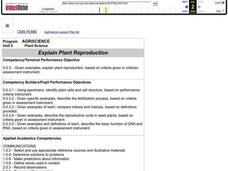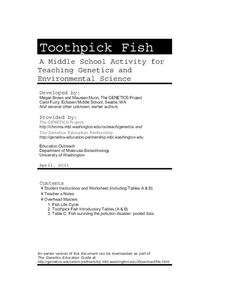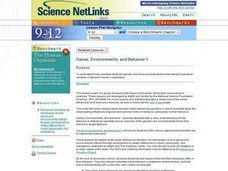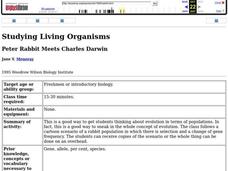University of Washington
Pasta Genetics
Four different-shaped and dyed pasta types represent four different alleles. Following a guide sheet, young geneticists practice randomly selecting alleles and discover the traits of the resulting offspring. This is a fun and solid...
Curated OER
Cell Wall Recipe: A Lesson on Biofuels
Biotech engineers discover that changes in the DNA code for cell wall formation can help create crops better suited for biofuel production. They extract DNA from wheat germ. They decode paper strips with codes and relate the activity to...
Curated OER
Characterization of the Bioluminescence (Lux+) Gene E. coli
Students grow E. coli strain HB101, which contains the plasmid pUCD607 with the bioluminescence (Lux+) gene. The plasmid containing the Lux+ gene is isolated from the E. coli, then characterized by restriction analysis.
Curated OER
7.012 Fall 2004 Section Self-quiz
This quiz just looks neat! It has two cell diagrams for biology class members to label. They also describe the function of each organelle. A prokaryotic and eukaryotic cell are displayed for them to compare, and then they fill in the...
Curated OER
Plant Reproduction
Students plant seeds in order to investigate and explore the questions: "How do seed companies develop varieties of plants?" and "What is the ideal plant?" Students will study related vocabulary and sketch seeds as they emerge. Students...
Curated OER
Raven Chapter 13 Guided Notes: Patterns of Inheritance
In this short space, it would be impossible to describe the breadth of this seven-page genetics worksheet. Geared toward AP or college biology learners, they explore not only the basic vocabulary and concepts, but also the Law of...
Curated OER
DNA Cut and Paste Activity
Here is a cut and paste activity worksheet designed for older students. They fill in the blank with information about the composition of DNA, then create a DNA strand with its complimentary nucleotide chain.
Curated OER
The Gene Scene
Sixth-grade scientists gain understanding of how genetic traits manifest with simple experiments, such as determining whether their tongues are roller or non-roller, taster or non-taster. Extensions include performing tests at home with...
University of Washington
Toothpick Fish
With colored toothpicks representing genes, youngsters practice passing them through generations of fish and learn about heredity. Consider this as an introductory activity since it does not represent recessive genes with lowercase...
Curated OER
How Big is a Gene?
Learners model the size and structure of a bacterial chromosome. In this genetics lesson, students attempt to fit strands of thread into a gelatin capsule. They relate the activity to the coiling of DNA into chromosomes in a bacterium.
Curated OER
Genetics Intro
In this genetics worksheet, students write in definitions for 11 terms associated with basic genetics. Students use Punnett squares to complete 8 short answer questions.
Curated OER
Who am I and Why?
Students make comparisons about themselves and others, which are real and meaningful. They study some basic concepts in the area of genetics and do a complimentary series of experiments, or explorations that illustrate these concepts
Curated OER
Peter Rabbit Meets Charles Darwin
Students start to think of evolution in terms of populations. The class follows a cartoon scenario of a rabbit population in which there is selection and change of gene frequency. They receive copies of the scenario or the whole thing...
Curated OER
Genes, Environments, and Behavior 1
Students examine how scientists study the genetic and environmental factors that interact to produce variation in behavior across a population.
Curated OER
DNA Extraction
Students extract the DNA from a strawberry. In this DNA technology lesson, students describe what they think DNA looks like. They use a procedure to isolate and extract the DNA from a strawberry.
Curated OER
Incomplete Dominance
In this biology instructional activity, students use the information given about genetics and Sponge Bob to complete each section of the sheet. They identify and explain incomplete dominance and use it to help them complete the questions...
Curated OER
Genes and Inheritance
Young scholars explore genes and inheritance. After listening to a story describing a rare genetic disease, students discuss inheritance and how living things pass on traits to their children. In groups young scholars, students...
Curated OER
Construction of a Hemoglobin Gene
Students see how eight pairs of triplets are equivalent to part of a gene and control a part of heredity. They comprehend how blood corpuscles manufacture normal hemoglobin. Students already comprehend that genes control the synthesis...
Curated OER
Gene Regulation Mechanisms
Young scholars explore the control of expression of DNA into proteins which is divided into two main categories: transcriptional and post-transcriptional. They construct examples of the control mechanisms and discuss disease processes...
Curated OER
Peter Rabbit Meets Charles Darwin
Ninth graders explore evolution. They study a cartoon scenario of a rabbit population in which there is selection and a change of gene frequency. Students discuss frequencies, evolution, and speciation.
Curated OER
Genes, Environments, and Behavior 2
High schoolers explore how scientists study the genetic and environmental factors that interact to produce variation in behavior across a population.
Curated OER
How Do Organisms Vary?
Students study variation of organisms. They determine this variation arises from genetic and environmental causes.
Curated OER
What is life? Word Search
In this biology activity, students locate and identify various vocabulary terms related to life biology. There are 48 words located in the puzzle.
Curated OER
DNA-a Molecular Identity
Pupils explore about what DNA is and several different DNA typing techniques. They examine three different situations where DNA typing was used to carry out justice. Students also identify and evaluate different uses of DNA typing...

























